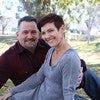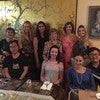Description
About This Video
Transcript
Read Full Transcript
Hi, I'm Jen as a fino and this is all hands on deck. Oftentimes when we start our [inaudible] practice, we're very focused on our spinal articulation and our core control and these are the things that require the most focus for us to work on our alignment and posture for the benefits that we know are important and particular to [inaudible]. And after we've been practicing for a while, we then see that those skills that we've gained through knowing the body from the inside will ultimately translate to the way we relate with our body to the outside. And today we're going to talk about one of the ways we do relate to the outside and our external environment, which is our hands. Most of us are involved in some kind of hand usage throughout the day, whether it's typing for long hours, texting or even in the plotty studio using our hands on the equipment. So whether you're a desk person or a [inaudible] pro, these are some simple exercises and skills that can help you to figure out just what you're supposed to be doing with your hands.
Now my teacher is was run Fletcher and he had an innate way of just working on awareness and discovery through the use of the hands. We would often say after class we laughed, we've cried, we picked flowers and words out of the air, but we always knew that the hands were important and he would also offer some imagery to us like holding something wonderful or very precious in your hand. As we moved our arms through space and this translated so nicely to what we were doing with our spines and how we could use our hands in a way that was more than just having them hang off the end of our arms. One of my favorite quotes or ideas from Ron was make your hands as articulate as your spine and so these next few exercises are going to do just that. So the first one we have is called fist and open. Very simply, we're going to start with the palms open and you're going to look right to the center of your palm because we're going to start again from the center just like we do in most things. PyLadies.
The idea is to start using the muscles in your hand to simply close your fist and make a soft fist, almost like you were holding a butterfly or a hummingbird in the palm of your hand and then slowly open your hand back out as if you were going to release that object that you were holding. So it's a nice easy way of just finding some small contractions through the center of the hand and then also some stretch of all of those muscles and skin and Fascia on the palm of the hand. We'll do this just a few times. Just say, you can see and as you do this, watch both hands and see if you can feel the difference between one hand to the other or also whether or not your hands move at the same rate of speed or seem to close and open as evenly. Um, knowing that most of us have one hand that's a little more dominant. Now once we do that a few times softly, we'll start to move into a little more muscular effort. So from here we're going to start the same way. Closing in the hand from the center, we're going to wrap the fingers in and then give a good squeeze.
And in this squeeze you should start to feel a little bit of engagement of your forearm muscles. And from here we'll open out. In this time we're going to go into a stretch. So this is probably the most intense jazz hand that you've done all day, but definitely something that you should feel energy through as if you could grow your fingernails from the tips of your fingers. So we'll close and open and you can play with the rate of speed that you work with. And you can also add some breath. If this were a Fletcher class, we would maybe go
So the next one we're going to do is articulating the thinkers one at a time. And this can prove to be a little more difficult. In fact, many people will think easy as pie, but once you actually start to differentiate between the movement of each finger, you'll start to understand just how challenging it is to really isolate the movement. So we'll start with the thumb this time and you're going to fold your thumbs in towards the center of your hands. And already you can see that this finger wants to come on. So I'm gonna and we'll see what that works, how that works out.
The second finger comes in, folds right over the thumb. The third finger comes in and I'm resisting with the other two. The fourth finger wraps in and finally the fifth and this time I'm hugging my thumb on the inside of my fingers rather than what we did a moment ago. I'm going to squeeze in and then I'm going to open back out to that Jaz hand position. So we're going some finger finger, finger, squeeze in and then open out thumb, finger, finger, finger, squeeze and open. Again, starting to feel the forearm muscles work as well as all of the digits of your hand and we might add a little breath again going
Most of us are going to start to curl into ourselves and fold into our hands this way so we can combat that by making sure that we have a ton of movement and range available. And if you can't go all the way, don't worry about it. Do what you can do and work on the range of motion that's available to you today. Now, once we've done a little flection extension, we can start to rotate the wrist. And my favorite thing to do as a figure eight, if you've ever done Indian dancing, this might come very naturally to you. But also you can start to feel this work up through the forms. And if you're holding your arms out in front of you, definitely feeling it in the shoulder girdle, moving the hands and starting to work on the articulation of all the joints at the end of the arm can create a really nice conversation all the way up into the shoulder girdle itself. So finally, when we take those together, fist and open single finger articulation and some rotation flection and extension, we get this wonderful exercise that Ron would do at the end of each class here and there. And um, it starts with the hands open and looks and sounds like this.
So we've worked on the movement of your hands and now let's work on a few exercises that we can use to use both, strengthen our hands and provide some stability. So the first one is a personal favorite of mine and it you need nothing but your hands themselves. We're going to work on taking the thumb to each knuckle and along each finger. And sometimes the first action of this exercise can be the most challenging and one that might need some extra work on over time. So simply place your thumb to your first knuckle and then you're going to slowly slide all the way up so that your thumb tip and your fingertips are touching without losing connection to your finger at all.
You're going to reverse that action. Sliding back down to the first knuckle. Move your thumb over to the second knuckle, slide up to the middle finger tip without losing that connection. Slide back down to that knuckle. Move to the next one, all the way up to the tip all the way down and finally over to the pinky finger, all the way to the tip and all the way down. Now while you notice, as you're working all of this musculature in here and you're also working on a grabbing type action, so let's do that once again. So we'll take the thumb to the first knuckle will slide to the finger, slide to the knuckle to this second knuckle without ever, Ooh, that one's tough for me without ever losing connection. You want to keep the bout the same amount of pressure through your fingertips, through your thumb tips, throughout getting all the way to the pinky and all the way back, and then you're going to reverse your steps.
Trying to be as specific and precise as possible, but the way that you do this, remember, if you're taking the time out to actually practice exercising your hands, you don't just want to get her done, but really make sure that the way that you're moving is part of the exercise itself and shake him out. Now he should be able to type a hundred words a minute easily. One of the biggest complaints I hear about being on the hands and balancing on the hands, whether it's an a plank pose or quadro pad on the Mat, is my wrists hurt. And so I heard a few anonymous talk about the fact that humans are known for the arrangement of their bones where it's one bone, two bones, lots of blobs, and then lots of digits. And so that structure says to me with especially to lots of blobs and lots of digits, that we have an opportunity there to find space between those blobs and digits and thus decompress our joints.
And also really be conscious about the way that we're aligning our hands for when we're wanting to bear weight on them. So let's take a look at the quad repaired position. We're going to take ourselves onto our hands and knees. And admittedly, when I first started [inaudible] my a strategy if you will, was to just put my hands underneath my shoulders, just like everybody said, hands underneath your shoulders, knees about underneath your hips. And then here we go. Well there's a few tips that you can use when lining up your hands that will make this relatively easier and work on the alignment, but first of which is to your index fingers and make sure in the alignment of your hands that your fingers are pointing directly ahead at the Mat.
So we're trying to avoid too much internal rotation or a bulldog type posture or too much external rotation. And if you can see on the wrist, internal rotation is gonna put a lot of pressure towards the inner edge of my wrist and not feel so great. Extrarenal rotation is going to put a lot towards the outer edge. But when my fingers are lined up and pointing directly forward from that index finger, I'm going to be looking at a nice flat line. No. This at some point might be even too intense for some. So adding a little bit of a lift under the risk can oftentimes help ease the position. Once we get into the position, we're going to start to think about the stretching and opening that we did earlier and the idea is to get all of the surface of your palm, all of the surface of the outer edge of the hands and then all of the digits to try to touch the mat.
Whether or not that's possible for you is going to depend on the openness and flexibility of your hands, but it's definitely something that we can all work for. So we're spreading those palms out, making a nice wide base of support. And sometimes it's nice to think of the three points that we use on the feet and actually use them like we would on the feet on the hands, so we might find the first knuckle, the fourth knuckle, and then someplace right underneath the center of the wrist or even towards the base of the thumb to hold weight. Once we have that set up and it feels pretty good, we're going to be aware of the surface that we're working on. So anything we put our hands on is going to give us back some kind of energy or some kind of force.
And we want to make sure that with our placement and with the energy of our body that we're meeting that force with this same amount of force that it's giving us. So in other words, if I put all of my weight forward into those hands, I'm probably exerting a little bit more force than the table or the mat is giving me. So I want to think about how much energy I'm receiving from the mat and then appropriately try to match that energy. So sometimes what this feels like is pushing the mat into the ground or pushing my body up away from the Mat. And what you'll notice when you do this action is that you start to get a connection that comes all the way up through the forum and right underneath the underarms. So we can really feel a nice strong connection to our shoulder blades.
The last part of this, we've spread our palms out. We've pressed the equal amount of force down into the mat and now we're going to imagine that we're pulling up on the forearms. So if you had a stocking along your forearm or if you had a kneecap at your elbow, it would be that same sensation of pulling the skin, pulling the muscle up and away from the risk to just create a little bit of decompression. This in and of itself turns into a very difficult exercise, so just holding the Quatar pet and you might not even need to go into the plank just yet at, but it's a great one to prepare you so that when you do go into the plank, you've got a nice wide and stable base of support and then you can work yourself into any number, pushups or balances as you go through. Another gem that I learned from Ron Fletcher was a lesson that he learned from Clara Palase and that was when working with equipment, whether it's the reformer, the chair, the Cadillac, or even the floor or the mat, which we all could also consider equipment to some degree that you work with the piece as if it's your partner. And Clara Palati said this, this machine is your partner. You don't work on it, you work with it. And what I would say to anybody who's working on the reformer in particular, and even the chair or anybody who's holding a bar, is to avoid choking the machine as much as possible.
Many times when we get on the pieces of equipment for the first time, it's a little daunting. It moves. We're not sure what to do. And even after we've been practicing for a while, if we try a new piece of movement that we haven't seen before, it's still has that kind of anxiety of where's my body exactly supposed to be placed. So when we're looking at the machine and let's talk, let's start with the foot bar. We want to make sure that that anxiety isn't evident within our hands. We want to make sure that we're setting ourself up with a great base of support so that we can go back to the lessons we've learned through our spinal articulation and stability and work from the proper place while working support from the upper extremity. So let's look at knee stretches first. We're going to start placing the heels back against the foot, the shoulder rest as much as possible, and then finding the position of the pelvis.
And instead of leaning forward to put our weight over our hands or to grip the bar, we're going to lift the arms up. Now I have long arms and hopefully if I bend my spine forward, I'll bring myself into a position where I'm supporting from my belly and I can place the heel of my hand directly onto the foot bar. Most of the foot bars nowadays have a really nice sense of traction. So if you remember what we worked on a moment ago in terms of meeting the pressure of, or the force of the piece that you're working with, we're going to try to meet that force by pressing through the palm, but we're not trying to meet that force by shifting the weight all the way over the hands because this is a passive way of supporting ourselves on the arms. Ultimately they'll do it for us, but it's not the most efficient or effective way to get the work we want to get.
So from here you'll notice that I'm spreading my palms out. I'm going back to that quadrant pet on the map idea of finding as much surface area as I can on my hands to really solicit a good connection and a good response from my hand to the foot bar. And from here I can work on my spinal position. When I start to push back, I've now got the strip springs working and oftentimes that will make me want to push with my arms. But I know that this exercise is not about the shoulders specifically.
I know it's at call the knee stretch, not a shoulder lift. So I want to start to work on stabilizing and anchoring my hands against the foot bar and moving from my legs. So as I press out, I'm actually pushing down into the bar a little bit more in as I push in or pull in and actually pushing into the bar a little more to maintain that same amount of force and pressure from the bar to my hand and from the hand to the bar. So you could say that I'm pushing and creating a bond through space and that ultimately I never want to have that bond change. I want the energy to maintain with some consistency throughout. Now taking that idea one step further, when we start to work with the straps, we're gonna have a little more challenge and most of us will want to force the straps into a range of motion that feels like we're doing something.
If we go back to the beginning of the discussion and think about the fact that we're working from the inside out. We're looking to have our hands in the movement of our upper body be an expression of the stability or the strength that's coming from the center. So the first thing we want to do with the arms is bring them into a position that allows us to again find that equal sort of resistance or force. My hands are moving into the straps. The straps are moving into my hands and I can stay here for a long time because I've created a bond.
Now instead of overcoming the spring with my arms, by forcing the movement forward and losing the connection to my spine, I'm going to take the bond that I've created and move it through space. So at each point throughout the movement, I want to feel that the pressure from the strap and into my hand and the hand into the strap is relatively unchanged. Now you might feel a little more resistance, but ultimately you shouldn't feel that resistance in your hand so much. You should feel it in your back. And your belly and your hamstrings and everything that's keeping your body upright throughout this exercise. If you start to work too fast, he might find that you lose your sensation. And that's a rule of thumb.
That speed kills sensations. So initially, see if you can work with a nice amount of pressure, if that pressure can only be maintained to this level, that's as far as you go. And then again, if you feel like you're losing it, you only come back to the point of tension so that you're really working on both ends of this spring. So things to remember are allow your hands to be articulate as your spine, as you're moving through space. Hold something wonderful in the palm of your hand and let your hands be an expression of who you are in that day. When you're reaching through space, whether it be on the mat or in space itself, grow your fingernails and reach beyond the depths of where you might be able to reach.
And finally that this machine is your partner and you work with it, not on it. I hope some of these tips will help you out in your practice. And thank you very much.
Comments
Great cues... beautiful explanations...and.. such nice voice.
I will for sure use your work in my classes.
Please come back with more
You need to be a subscriber to post a comment.
Please Log In or Create an Account to start your free trial.
























